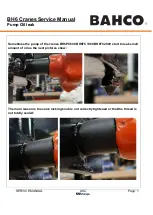
FERNO/MAN/0721/216-R22/UK
41
8.4 - Unloading the Trolley From a
Vehicle Fitted with Ramps
1. Make sure that the patient is disconnected from any vehicle
mounted apparatus or instrumentation.
2. Operation by a minimum of two operators at all times.
3. Disengage the trolley from the two part locking device by
depressing the foot pedal (manual lock) and roll the trolley
to the rear of the ambulance compartment.
4. Unfold the push/pull handle and ensure it is locked in the
extended position.
5. Using two operators guide the trolley down the ramp and
out of the vehicle.
6.
If your Trusts protocol is to use a winch, follow the
manufactures guidelines in line with local manual handling
protocols.
8.5 - Loading the Trolley into a Vehicle
Fitted with a Tail Lift
1. Make sure that the patient is secure at all times whilst on
the trolley.
2. The trolley is loaded with the patient's head towards the
front of the ambulance.
3. Ensure that the trolley is in its lowest position and there are
no trailing straps, blankets etc.
4 Guide the trolley on to the tail lift, head end first.
5. Operate the tail lift as per manufacturers’ instructions.
6. Once the tail-lift is in the raised position, push the trolley
forward and secure in the Ferno 2 part lock
8 - PREPARING TO MOVE THE TROLLEY
8.1 - Manoeuvring the Trolley
It is recommended to move a patient with the trolley in the lowest
position wherever possible, as this minimises risk of tipping.
POWERX can be moved in the raised position providing operators
risk assess the suitability, condition and gradient of surface they
are moving over, especially when moving over rough ground,
cambers or low inclines.
It is also important to ensure there are sufficient operators holding
the trolley when manoeuvring to maintain a stable movement
throughout the transfer, wherever possible with heavier patient
weights using more than the minimum recommended 2
operators.
It is recommended to always move the trolley in the lowest
position when transferring on and off a vehicle via a tail-lift or
ramp.
1. Transporting a patient on the trolley should always be
carried out with the side rails raised and the upper-body
harness and leg straps fastened and suitably tightened.
2. The trolley is recommended to be operated by at least two
people at all times.
3. If low obstacles (such as door sills) are encountered, move
the trolley as close as possible and lift the leading wheels
over the obstacle. Repeat for the trailing wheels. Note
that utilising the side-manoeuvring handles available on
POWERX make this operation easier and with reduced injury
risk.
4. High obstacles such as curbs or steps, rough terrain, etc.
should be recognised as potentially hazardous to smooth
rolling and trolley balance and may require physical
assistance or an alternative route.
5. Ensure that the harness and straps are fastened around the
patient. Place the trolley in the lowest position possible.
However the trolley may be wheeled in a semi-elevated
position along hospital corridors or similar smooth level
surfaces, provided that the patient is securely strapped to
the trolley and that the two attendants are in control of the
patient and trolley at all times.
6. Where available, attach winch to the trolley winch-link to aid
transfer into vehicle
8.3 - Loading the Trolley into a Vehicle
Fitted with Ramps
1. Make sure that the patient is secure at all times whilst on the
trolley.
2. The trolley is loaded with the patients head first towards the
front of the ambulance.
3. Ensure that the trolley is in its lowest position.
4. Ensure that the push/pull handle is locked in the extended
position.
5. Position the trolley at the base of the ramps, head end first.
6. The cotsides are intended to provide patient safety and
must not be used for lifting or manoeuvring the trolley.
7. With one operator at the head end pulling and one operator
at the foot end pushing simultaneously, the trolley can now
be advanced into the vehicle. If a winch is fitted then this can
be attached to the head-end of the trolley to aid loading.
8. Secure the trolley into the Ferno 2 part-lock for transportation.
Preparing to Move the Trolley
Winch link attachment
8.2 - MCF Winch Link Attachment
The winch link connector aids the loading of a trolley into an
ambulance with a ramp. The ambulance must be fitted with a
winch mechanism with a MCF specification buckle.
To operate, attach to the winch from the ambulance to the winch
buckle situated on the trolley base at the head-end of POWERX.
Follow the winch manufacturer's instructions and recognised
local manual handling protocols to winch the trolley into the
vehicle.
WARNING
Do not lower or raise the trolley with the foot-end
frame fully shortened
Summary of Contents for POWER X SN-POW1001
Page 48: ...FERNO MAN 0721 216 R22 UK 48...
Page 50: ...FERNO MAN 0721 216 R22 UK 50...










































